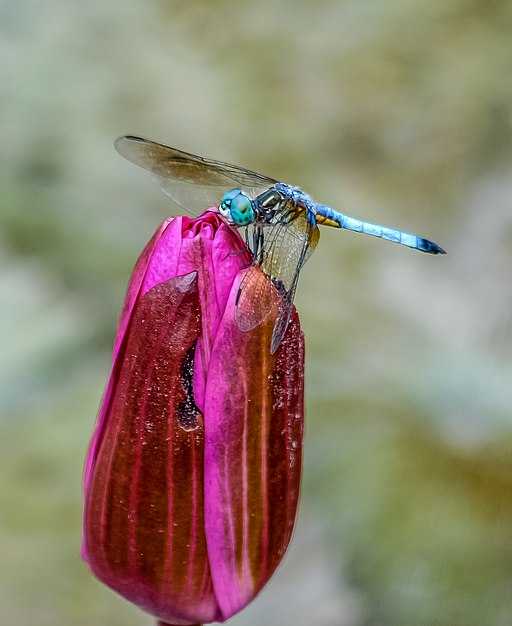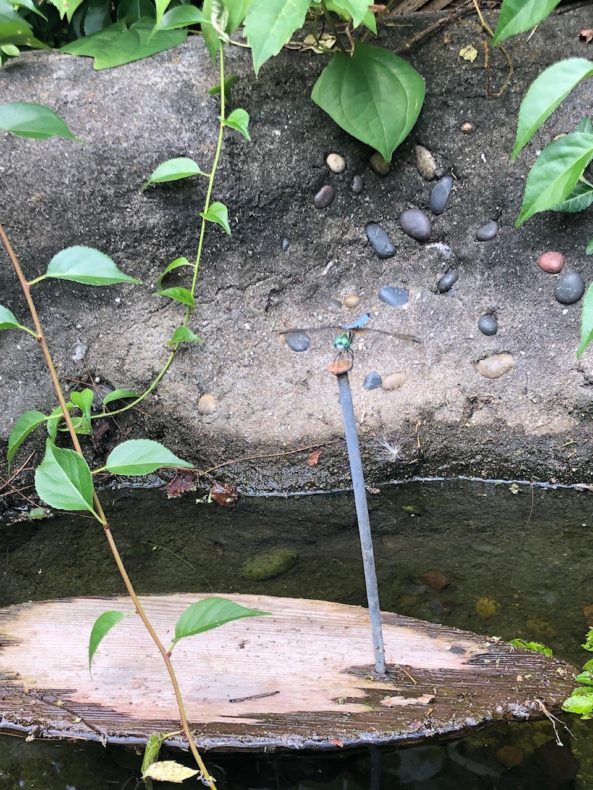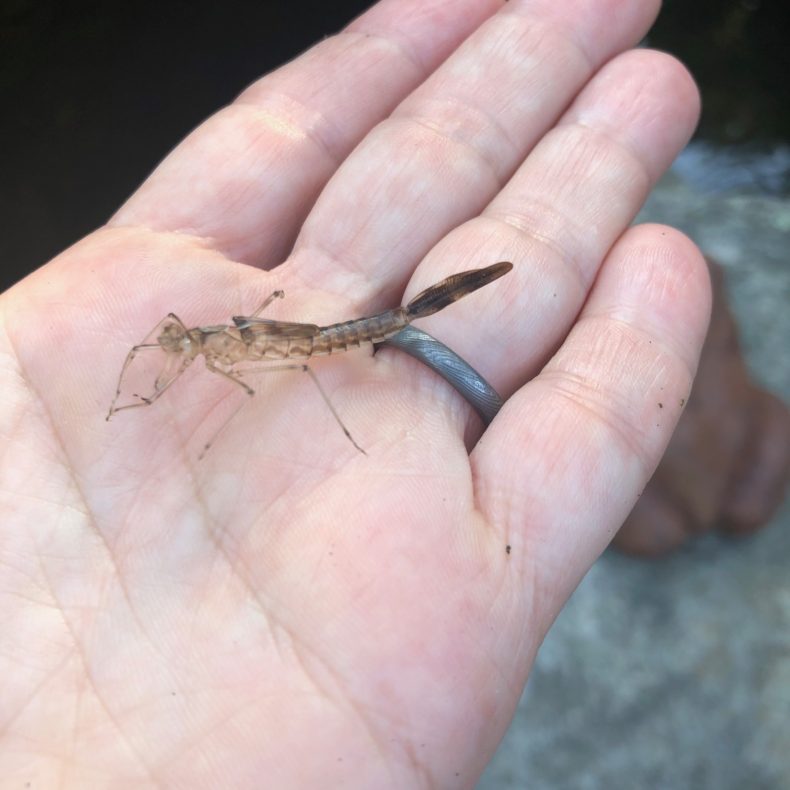
My latest happy distraction is the candy-stick of a male dragonfly that has taken over my backyard pond. A gorgeous blue dasher, he zips (dashes!) in circles around me, hovers remarkably close to my face like some tiny drone, then finally alights on a twig nearby, watching me—truly watching–with his cartoonishly large compound eyes. His funny little face twitches periodically, as though the whole thing is blinking. When perched, he’ll curl his abdomen up toward the sky, an “obelisk” posture that I thought surely was a gesture akin to the middle finger (these guys are super territorial), but which instead helps regulate body temperature by reducing the surface area exposed to the sun.
The dasher’s Latin name, Pachydiplax longipennis, means “long winged.” (Why, what were you thinking?) Its wings are actually pretty standard sized for dragonflies.
I’ve always found it fascinating how little blue there is in nature. Where it exists, it is achieved with structures and light, not pigment. The dashers apparently heard about blue’s rarity. They said Hold my beer.
They even slapped on some black stripes, a yellow “belly” patch, and metallic green eyes, for extra pop.
A couple of weeks ago, and for several days, I watched this truly stunning, definitely blue insect fend off a rival. The two were identical to my untrained eye, battling it out, at times quite roughly. They’d do frantic loops together, one chasing, one chased, then suddenly they’d rocket in tandem up into the sky. A moment later they were back doing loops again. They’d collide with a click as one tried to bite the other. Their transparent wings whirred.
Then, on the third morning, I came out to a stray wing floating in the pond and a single male (wings intact) accosting me on my approach. The war was won.

That very day, here came the victor’s mate—brown bodied, red eyed—and my boy gave chase. Courtship, at least what I caught of it, was brief, and suddenly they were fully engaged: He held her neck with the claspers on his abdominal tip (their shape is species specific, fitting perfectly into groves behind her head), and she curled her own abdomen to receive his sperm. Their sexual contact formed, as it always does, the conspicuous heart shape of dragonfly love.
All business after the deed, the female then dropped down to the pond and dipped the tip of her abdomen over and over, a finger lightly tapping a table, laying eggs on the calm surface. (Her mate remained vigilant above her, and would dart at me if I leaned in too close to watch.) And then, without fanfare, she was gone from this place.
The eggs? A clump of tiny white dots might have been they, though I couldn’t say for sure with so many bits of detritus coating the admittedly dirty pond. My eyesight isn’t what it once was, and Daddy Dasher didn’t like me squatting at the pond’s edge for a better look. So, I hoped it had been a successful laying and backed away, apologizing aloud for my intrusion.
But shortly after, I was back, this time turning my attention to the submerged nymphs—the result of a previous pairing, obviously–a couple of weeks old (my guess), not yet equipped for life on land. A few inches below the water’s surface, looking like fallen twigs, they leaned against the pond’s stone walls, big-eyed, clingy, twitchy things. I counted eight right off, dull gray-brown with muted stripes, not yet magnificent. Their tails ended in forks. When startled, they disappeared in a hurry. I tried to catch one in a fine-mesh net so I could examine it up close. It shot out from my scoop, stirring up a sediment cloud that helped it disappear.
Rounding out the day, I discovered a nymph attached to the dry slate at the pond’s edge, but, on poking it gently, I found it was just a shell. Here, the once-aquatic beastie had emerged knowing just what to do next: It wriggled its inside out, snapped open two sets of perfect wings, and flew.

How lovely it all was. Because how often, in nature, do we get the whole story in a single day?
————
PHOTOS: Dragonfly on tulip borrowed from WikiMedia Commons.
The others are mine.
A lovely post. Another on the theme of ‘noticing’ nature during lockdown. So good to ‘re-connect’ in this way and see such epic stories of life and death and rebirth play out in our backyards.